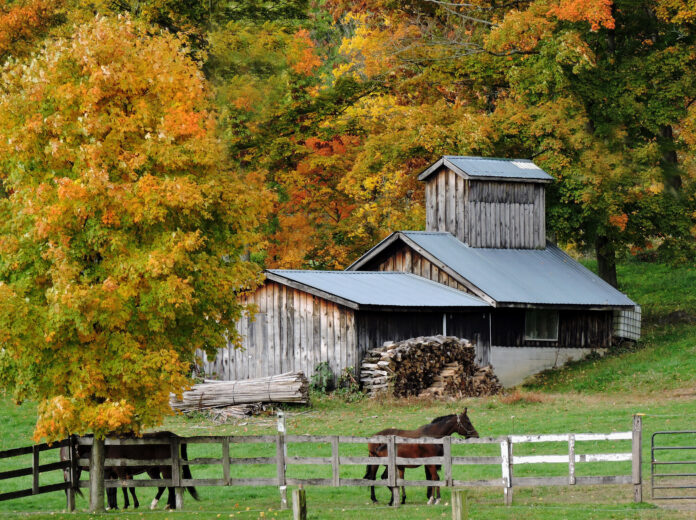
There is nothing quite like the first three weeks of autumn. As searing summer temperatures cool, I find myself throwing open the windows at bedtime, allowing the crisp night air to waft across me. I most definitely sleep more soundly in autumn. There are few things that measure up to the scents as the sun warms the fallen leaves, baking them into a crispness that fills the autumn air with an intoxicating aroma. And then there is the breathtaking display of colors — those dazzling shades that send photographers into a tizzy, planning their routes in the hope that they won’t miss a perfect shot. That would be me.
And just how do those colors come to be? It’s a crazy thought but those vibrant shades are sitting there in the leaves of deciduous plants all summer long. We just can’t see them because they are masked by the green chlorophyll. Chlorophyll is a pigment that takes the energy of the sun and converts it into food. This process is referred to as photosynthesis. As long as the summer is warm and sunny, the plants will continue to manufacture this chlorophyll.
In autumn, shorter days dole out less sunlight and the nights begin to cool considerably. These triggers signal to the plants that the time for producing chlorophyll is over for the year. As the green pigments begin to break down into smaller molecules to be stored by the plants, voila, the colors begin to show through.
Pigments

In addition to chlorophyl, leaves contain three other pigments: carotenoids which produce shades of orange, anthocyanins which result in brilliant reds and xanthophylls which create yellows. You may have noticed that each species of tree consistently produces a characteristic color as a result of the pigments which are most dominant in their leaves. For example, hickories turn a mustard-yellow, oaks a brownish-russet and maples, a spectacular mix of brilliant oranges, yellows and reds. I love to look across the landscape in autumn and challenge myself to identify the tree species by their color alone. These colors help to identify the various forest types that are growing in different areas.
Here in northeast Ohio, Geauga County is the maple syrup capital of the state. The abundance of sugar maples that makes this possible results in an autumnal display that takes your breath away, easily rivaling the forests of New England. Wood edges lined by maples, each one turning its own radiant color, remind me of a roll of lifesavers.
Perfect conditions

Not every autumn is spectacular, however. The brilliance of the colors is directly related to weather conditions — not only those at the time of change but those that occurred throughout the spring and summer of the year. The biggest factors that influence fall color are sunlight, moisture and temperature. In fact, no two autums are ever alike because the combinations of these three factors are never the same. In a perfect world, the most spectacular displays result from a warm, rainy spring combined with a hospitable summer and comfortable, sunny fall days contrasting with cool, frost-free nights.
When all the chlorophyl has dissipated and the leaves have had a chance to display their breathtaking glory, a tiny layer of cells between the leaf’s stem and the branch, known as the abscission layer, breaks down, releasing the leaf from its hold. In its newfound freedom, the leaf sails at liberty, eventually coming to rest upon the ground among thousands of others. Here, their duty has only just begun.
Think of the leaves as a giant blanket covering the ground. This covering offers a protective layer for many different organisms, providing both food and shelter for small mammals, amphibians, reptiles and insects which depend on the leaves for protection from predators and harsh weather. As an example, the caterpillars of Luna and Polyphemus moths form their cocoons in the leaves of their host tree which then fall to the ground in autumn where they will overwinter beneath the protection of this blanket. Fallen leaves also provide an important habitat for birds as they seek out hidden insects that will fuel them during their fall migration.
As the leaves begin to break down over time, they release important nutrients, such as nitrogen, into the soil. This natural fertilizer not only provides food for many organisms that aid in its breakdown, but results in better growth and health of the plants which thrive on it. The decomposing leaf litter creates a protective layer that keeps the soil damp by reducing evaporation. Suffice it to say, this annual replenishment of leaves contributes greatly to the health of the ecosystem.
Leave the leaves

That being said, I will now climb upon my soapbox to tell you to LEAVE THE LEAVES! In a perfect world, people would simply leave the leaves where they land in their yards to overwinter until spring. But unfortunately, humans have a love affair with their grass and so they rake. They rake and rake and rake and then, they light the pile of leaves and animals within on fire. As I drive though the countryside on sunny autumn days, I am horrified by the number of fires I see emanating from piles of burning leaves. I can almost imagine the tiny voices screaming out in terror as the flames engulf the many different organisms which innocently sought shelter beneath Mother Nature’s blanket. On days like this, when the air filled with smoke pollution, I can do nothing but go home and go inside, dejected. If you burn your leaves, you can certainly do better. Consider raking them onto a tarp for relocation into a wood edge or side yard. Dump them on your garden for winter protection of your plants or place them on a compost pile. In this manner, you are buying time for the organisms within, giving the leaves a chance to give back to the environment from which they originated. Leaves play a vital role in maintaining healthy ecosystems. Surely, such an act of compassion will make you will feel better about yourself — I know the animals will appreciate it, and so will I.
















You have done it again,Tami,with an excellent article which I would not have read if I had not already known your articles can be right on track and super informative!
Explained in such a way that even I (underlined) can explain to others,photos showing autumn at its finest.Thank you for noting the importance of NOT burning leaves.
We rake here,then pile onto raised beds,where,by Spring,there’s black gold free for the taking,nourishing the organic beds,ready for what is planted in Spring.Many thanks for giving people something to think about.We must be better stewards of the land,
and considerate of all living things.